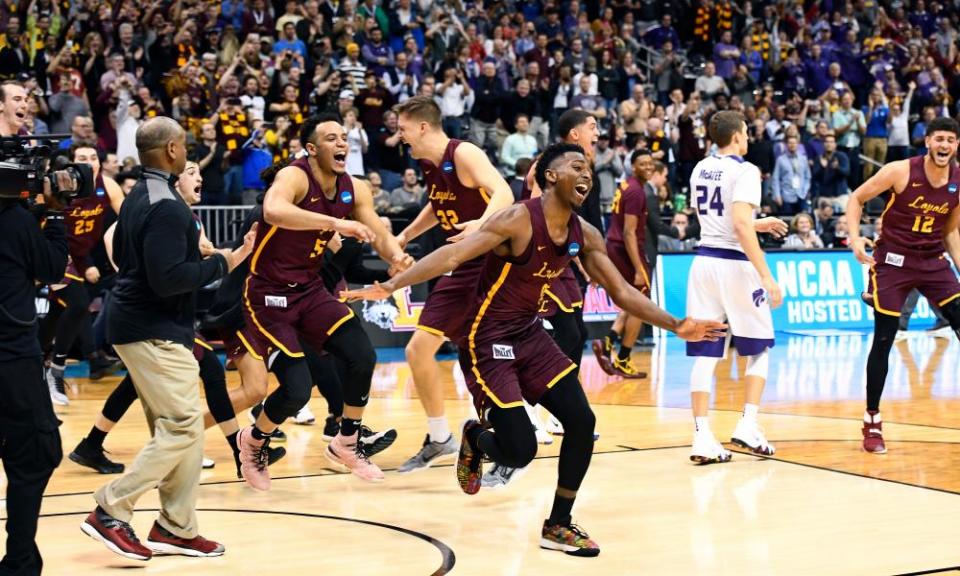Loyola Chicago's Final Four run: how an underdog restored a city's basketball glory
A city once synonymous with basketball excellence has had little to cheer about in the two decades since Michael Jordan left town, but the Ramblers’ Cinderella run to the Final Four has changed that

There was a time when Chicago was synonymous with basketball excellence, a major point of civic pride. Michael Jordan and the Bulls of the 1990s ruled the city and inspired a generation of devout fans. As one of them myself, I loved every minute of the Bulls’ glory years, and spent countless hours in my driveway pretending to be Scottie Pippen tasked with hitting a last-second shot or Dennis Rodman snagging a tough rebound. Basketball gave me a sort of joy that I hadn’t known before, and it was all thanks to the Bulls’ dominance.
It felt like the winning would never stop, but one day it just … did. After clinching the team’s sixth championship in eight seasons, Jordan called it quits for the second time in 1999, abruptly ending the team’s dynasty and ushering in a new dark age for basketball fans across the city. We’d had no idea just how great we had it, and even less of an understanding of how bad it was about to get.
The following season, the team finished dead last in the Central Division, as they did for three more years. It wasn’t until the 2004-05 season that the Bulls returned to the playoffs, and even then, they were knocked out fairly easily in the first round. They reached the Eastern Conference finals during the 2010-11 season, inspiring hope of a new dynasty, only to be blown out by LeBron James’ Miami Heat in five games. Then Derrick Rose, a homegrown prodigy who emerged from Chicago’s South Side to become the youngest NBA Most Valuable Player in history, wrecked his knee the following season and was never the same, returning the city to a default state of post-Jordan malaise.
The truth is, simply, that there hasn’t been much basketball in Chicago worth getting excited about in nearly two decades. That extended to the college game: None of the four Division I schools within city limits – Loyola University Chicago, DePaul University, Chicago State and the University of Illinois at Chicago – had even reached the tournament in 14 years until the Ramblers made the field as an No11 seed earlier this month.
But that’s all changed dramatically over the past fortnight as the Catholic school on the city’s North Side has made an improbable run to the Final Four of this year’s NCAA tournament. Loyola last made the national semi-finals in 1963, winning the title when the tournament was a silhouette of the billion-dollar cultural event it’s since become. But it had been 33 years since they’d even earned an invite to Big Dance.
For Chicago fans, Loyola’s Cinderella run is a welcome chance to step out of the cold shadow of Jordan’s statue outside the United Center and once again feel what it means to be excited about local hoops. Looking around, you can’t miss it. The city is draped in the school’s maroon and gold colors, local bars are holding viewing parties, and campus bookstores are packed with fans ready to jump on the Loyola bandwagon. Sister Jean Dolores Schmidt, the team’s 98-year-old chaplain, has found herself elevated to national celebrity and treated as a sort of nonagenarian rock star. There’s a feeling of electricity buzzing through the city, a sense of early-spring joy, making it a positively delightful time to be a fan. To be sure, there’s a lot of pressure on the young Ramblers to make their city proud, but in Chicago, their age might just be their most valuable asset.
Seen on Lake Shore Drive. #LoyolaChicago #GoRamblers #MarchMadness pic.twitter.com/PeZZAJQA6Y
— James Martin, SJ (@JamesMartinSJ) March 25, 2018
There’s not a single player on the Loyola squad old enough to remember the Jordan-era Bulls – and maybe that’s a good thing. When the Bulls took the court to begin their record-setting 72-win season in November 1995, Ramblers stars Clayton Custer and Marques Townes were just four and two months old, respectively. Nobody on the Alamodome court will remember John Paxson’s series-clinching three-pointer in the 1993 NBA finals or the time Jordan laced up his shoes and dominated the Utah Jazz while fighting off the flu. Nobody will remember what it’s like to live in the city where on-court excellence is an expectation and losing is all but unacceptable. To them, this is a new phenomenon and a chance to create their own legacy without being haunted by the ghost of greatness past. It’s a good thing for players and a great thing for fans.
Whether they take home the title or return empty-handed from their trip to San Antonio, Chicago has a lot to be thankful for when it comes to the excitement these young men have given us. It’s good to remember what it’s like to feel optimistic about basketball in Chicago, a welcome break from two decades of mediocrity. With the Bulls once again in full rebuild mode after the departures of Rose and Jimmy Butler, this year’s Loyola run may just be a temporary reprieve from the new normal. Nothing will ever be able to fill the Jordan-shaped hole in Chicago basketball fans’ hearts, but the Ramblers’ unforgettable run is the next best thing.

